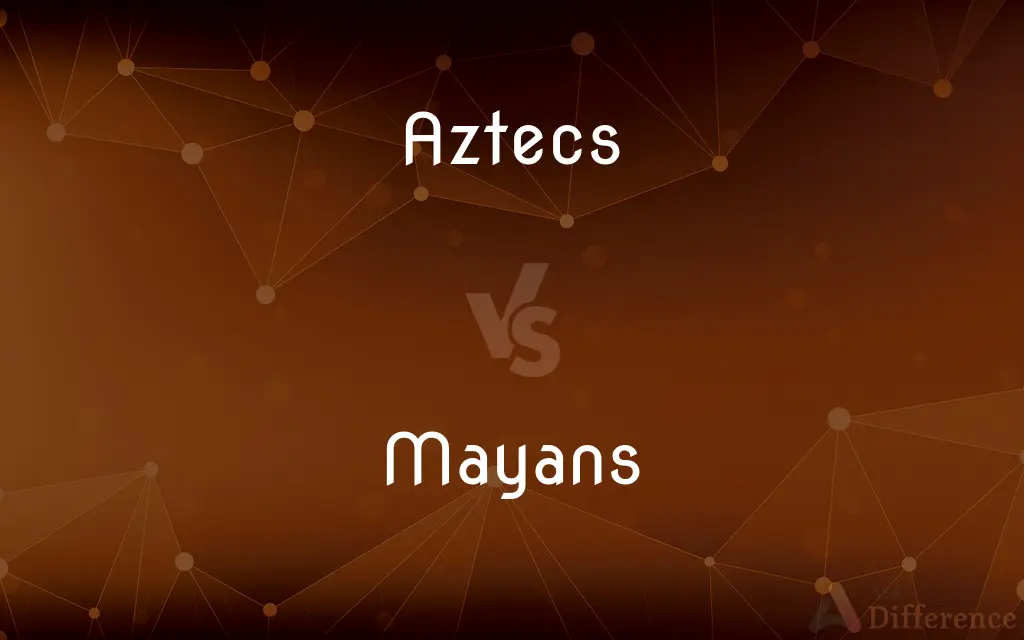Aztecs vs. Mayans — What's the Difference?
By Tayyaba Rehman — Published on October 14, 2023
The Aztecs were a Mesoamerican culture in central Mexico, known for their capital Tenochtitlan, while the Mayans inhabited the Yucatán Peninsula and developed a renowned calendar system.

Difference Between Aztecs and Mayans
Table of Contents
ADVERTISEMENT
Key Differences
Both the Aztecs and the Mayans were ancient Mesoamerican civilizations, but they thrived during different periods and in distinct regions. The Aztecs, primarily located in what is today central Mexico, came to power centuries after the decline of the Mayan civilization. Their capital city, Tenochtitlan, on Lake Texcoco, would eventually become modern-day Mexico City.
The Mayans, conversely, occupied the regions that are now southeastern Mexico, Belize, Guatemala, and parts of Honduras and El Salvador. They are often remembered for their intricate hieroglyphic writing system, advanced mathematical and astronomical studies, and their intricate calendar system. The Mayans peaked during the Classic period (250-900 AD) with impressive cities like Tikal and Chichén Itzá.
While the Aztecs are recognized for their military prowess, massive tributary empire, and human sacrifices to their gods, the Mayans are celebrated for their cultural achievements in arts, architecture, and their multifaceted understanding of their environment. The Mayans' decline is believed to have started around 900 AD, while the Aztec empire came to an end with the Spanish conquest in the early 16th century.
Religion played a pivotal role in both Aztec and Mayan societies, influencing their rituals, daily activities, and architectural feats. However, their pantheons, while having some overlap, consisted of different deities and mythologies. Ultimately, while the Aztecs and Mayans share a Mesoamerican heritage, their distinct evolutions, achievements, and cultural nuances set them apart.
Comparison Chart
Geographic Location
Central Mexico
Yucatán Peninsula and surrounding regions
ADVERTISEMENT
Time of Flourishing
Late Postclassic period (13th-16th centuries AD)
Classic period (250-900 AD)
Known For
Military might, Tenochtitlan, human sacrifices
Hieroglyphic writing, calendar, cities like Tikal and Chichén Itzá
Decline
Spanish conquest in the early 16th century
Began around 900 AD, reasons still debated
Language
Nahuatl
Various Mayan languages
Compare with Definitions
Aztecs
A Mesoamerican civilization known for its vast empire and capital city Tenochtitlan.
The Aztecs built impressive pyramids in their capital, Tenochtitlan.
Mayans
An ancient Mesoamerican civilization recognized for its unique hieroglyphic script.
The Mayans recorded history and knowledge using an intricate system of glyphs.
Aztecs
A civilization with advanced knowledge of agriculture, especially maize cultivation.
The Aztecs constructed chinampas, or floating gardens, to maximize crop yields.
Mayans
A group with an extensive understanding of mathematics, including the concept of zero.
The Mayans used a base-20 numeral system in their calculations.
Aztecs
The last great indigenous empire in Mexico before the Spanish conquest.
When the Spanish arrived, the Aztecs were at the height of their power.
Mayans
A culture that developed an accurate calendar system based on their astronomical observations.
The Mayans' calendar predictions led to various modern-day myths and speculations.
Aztecs
A society that spoke the Nahuatl language.
Many Nahuatl words from the Aztecs, like chocolate, have been integrated into English.
Mayans
A society that thrived in regions of present-day southeastern Mexico, Belize, and Guatemala.
Mayans cultivated cacao, the foundation for chocolate, in the tropical climates they inhabited.
Aztecs
A group famous for their complex religion and ritualistic human sacrifices.
The Aztecs conducted ceremonies to appease their gods and maintain cosmic balance.
Mayans
A civilization with city-states like Tikal and Chichén Itzá, known for their architectural marvels.
The Mayans constructed grand temples and pyramids in honor of their deities.
Aztecs
A member of a people of central Mexico whose civilization was at its height at the time of the Spanish conquest in the early 16th century.
Mayans
A Maya.
Aztecs
The Nahuatl language of the Aztecs.
Mayans
A linguistic stock of Central America that includes Quiché and Yucatec.
Aztecs
Of or relating to the Aztecs or their language, culture, or empire.
Mayans
Of or relating to the Maya, their culture, or the Mayan linguistic stock.
Common Curiosities
Where did the Mayans live?
The Mayans inhabited the Yucatán Peninsula and surrounding regions.
What writing system did the Mayans use?
The Mayans used a unique hieroglyphic script.
Who were the Aztecs?
The Aztecs were a Mesoamerican civilization that flourished in central Mexico.
Was Tenochtitlan an Aztec or Mayan city?
Tenochtitlan was the capital city of the Aztecs.
Share Your Discovery

Previous Comparison
Heed vs. Attention
Next Comparison
Current Liabilities vs. Non Current LiabilitiesAuthor Spotlight
Written by
Tayyaba RehmanTayyaba Rehman is a distinguished writer, currently serving as a primary contributor to askdifference.com. As a researcher in semantics and etymology, Tayyaba's passion for the complexity of languages and their distinctions has found a perfect home on the platform. Tayyaba delves into the intricacies of language, distinguishing between commonly confused words and phrases, thereby providing clarity for readers worldwide.














































